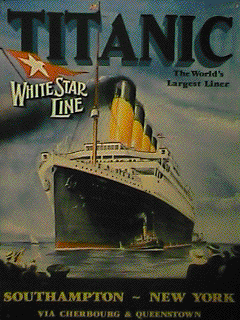
Model Ships
General
I love model ships, particularly models of working ships. I do occasionally build a warship (there are a couple towards the bottom of this page), but I far prefer ships that people use to make a living, further commerce and so on. On this page you'll see a number of ships from my collection, most of them models I have built.The image at left is not a model - it's one of my collection of tin signs. It's the only one I have with a ship theme, most of them are of ladies. If you'd like to browse the images I have online of my tin sign collection, click here.
I keep this sign in the bathroom - just in case one of my guests is having that "sinking feeling"...
The Fishtank
This is a picture taken with a CASIO QV-10a digital camera of my fishtank. Inside you can see a sunken cargo ship complete with damage to the hull, rust & other aging artifacts.
This ship actually has lights built onto the masts, and some pretty reasonable detailing throughout. It looks pretty neat in there, don't you think?
The first thing people ask me is "doesn't the glue & paint & plastic hurt the fish?" The answer, I believe, is no. Or at least, not that I can tell. This particular tank has been stable for about a year as I write this, no fish lost to any cause at all. They all have normal appetites, I've had no problems with disease at all, and they are about as active as I would expect. The model has been in there all the time. The tank has two undergravel filters and an above-tank "waterfall" filtration system as well, charcoal gas filters & fiberglass particle filters. This is all pretty normal for any good tank system, and if it is what is making the model "ok" for the environment in there, that's just dandy. I maintain the tank only by changing the filter elements about once every 60 days or so, and watching the PH, which remains stable as long as the fish are not overfed.
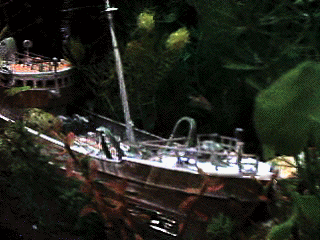
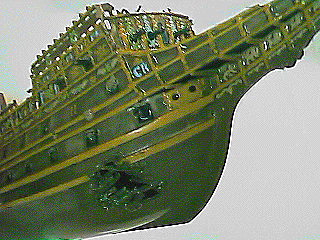
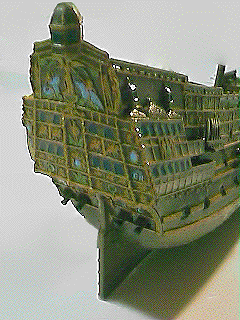
Modelling TipYou might have noticed that both the galleon and the sunken freighter have damage to the bow; it looks like there was an impact there. I did this so that the sunken ships would have a visual reason to be sunken. It's not meant to be viewed out of the water. I created that effect using the steps shown to the right:
 Click for larger JPEG This looks outstanding under water... plus, small fish use it to swim in and out of the model, which looks neat - like a scene from all those underwater movies we endured in the 60's... I also suggest detailing the models with rust and various aging artifacts... barnacles, coral, that kind of thing. Barnacles appear as clusters of tiny white dots; coral is multicolored and very irregular looking. For rust, you mix red paint with thinner, and stroke it on with a very small brush, then smear it with a paper towel. Repeat until you're satisfied. If the rust is to have occurred during the ship's working life, it'll go downward, following water as it flows down the ship's sides. If it's meant to look like it happened after it sunk, it can be uniform and not related to gravity at all. I hope this is useful to someone. If you use this tip, do me a favor and tell me... here's the email: ben@blackbeltsystems.com |
|
Texaco Tanker

Texaco Tanker Toy (not a model)
This is my pride and joy - a Texaco Tanker in excellent condition. This is a toy that was made available at Texaco gas stations when I was a child. I was given one, and I loved it. I don't actually know what happened to it, but my guess is I probably wrecked it one way or another. Aside from the obvious risks like floating it in unreasonable places (like the Delaware River), I had a penchant for fire and explosives when I was a child. I'm afraid that this thing might have been one of the ships I burned to the waterline in the bathtub with towels stuffed underneath the door... Man, does that ever make a mess. And my mother sure got annoyed! But I digress.
I'd been looking for another Texaco Tanker (this one!) for over thirty years, and I finally found this with an internet search via Alta Vista, after searching the internet for several years about once a week. I was hoping that one would show up, and eventually, it did. The person from whom I got the ship informed me that it was a collector's item, and charged me accordingly. This is what you would call a delayed penalty for losing the first one, I suppose.


The ship is in truly excellent condition, as is easily seen from the image here. The only damage is a missing blade from the propeller and two missing small masts. It even has all the original decals, right down to the depth markings at the waterline. I don't have the box for it, which is apparently an issue for collectors - but I really don't care. It lives in a glass "barrister's bookcase" and has pride of place on the top shelf. It'll never be in a box of any kind again as long as I own it.

Freighter

Freighter
Fishing Boat
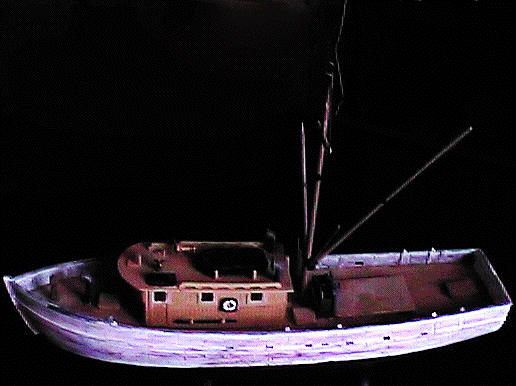
Fishing Boat
This boat - it's not really a "ship", per se - operates in the coastal waters. It is not large enough to withstand serious weather, though boats like this have braved some pretty rough seas. I had some fun detailing it (with paint) because the scale is large enough that you can get at individual items such as planks and so on.
Warships

|
Battleship & Bridge |

|
They make me uncomfortable, yet I cannot say I am unimpressed by a ship of war. I've been aboard both a battleship and an aircraft carrier, and unless you've been on one, you just can't get a good idea of the sheer size of these floating fortresses. I've been in a sub also, and the contrast couldn't be more complete - the world war two era boats are cramped, full of dangerous projections and surfaces, and seem an unlikely place to have to spend months at a time. I have pictures here of both a battleship and a sub from my collection, plus a close-up of the bridge area of the battleship.

WW II Era Submarine
What's Next?
I have quite a few models in the box, ready to build the next time I get enough time to have a go at one or more of them. Here's a list of the interesting ones:- Hope - Hospital ship
- Haven - Hospital ship
- Hikawamaru - Japanese special hospital ship
- Queen Mary - Passenger Liner
- Shell Welder - Coastal Tanker
- U.S.S. Burleigh - Naval freighter
- U.S.S. (unknown) Naval Ship #41 - Naval Tanker
- H.M.S. Victory - English battleship (this is a multideck sailing vessel)
- N.S. Savannah - Nuclear Freighter (NS = Nuclear Ship)